Starlight: His disabled son’s amazing gaming life in the World of Warcraft
This is best and most important story I have read in a long time.
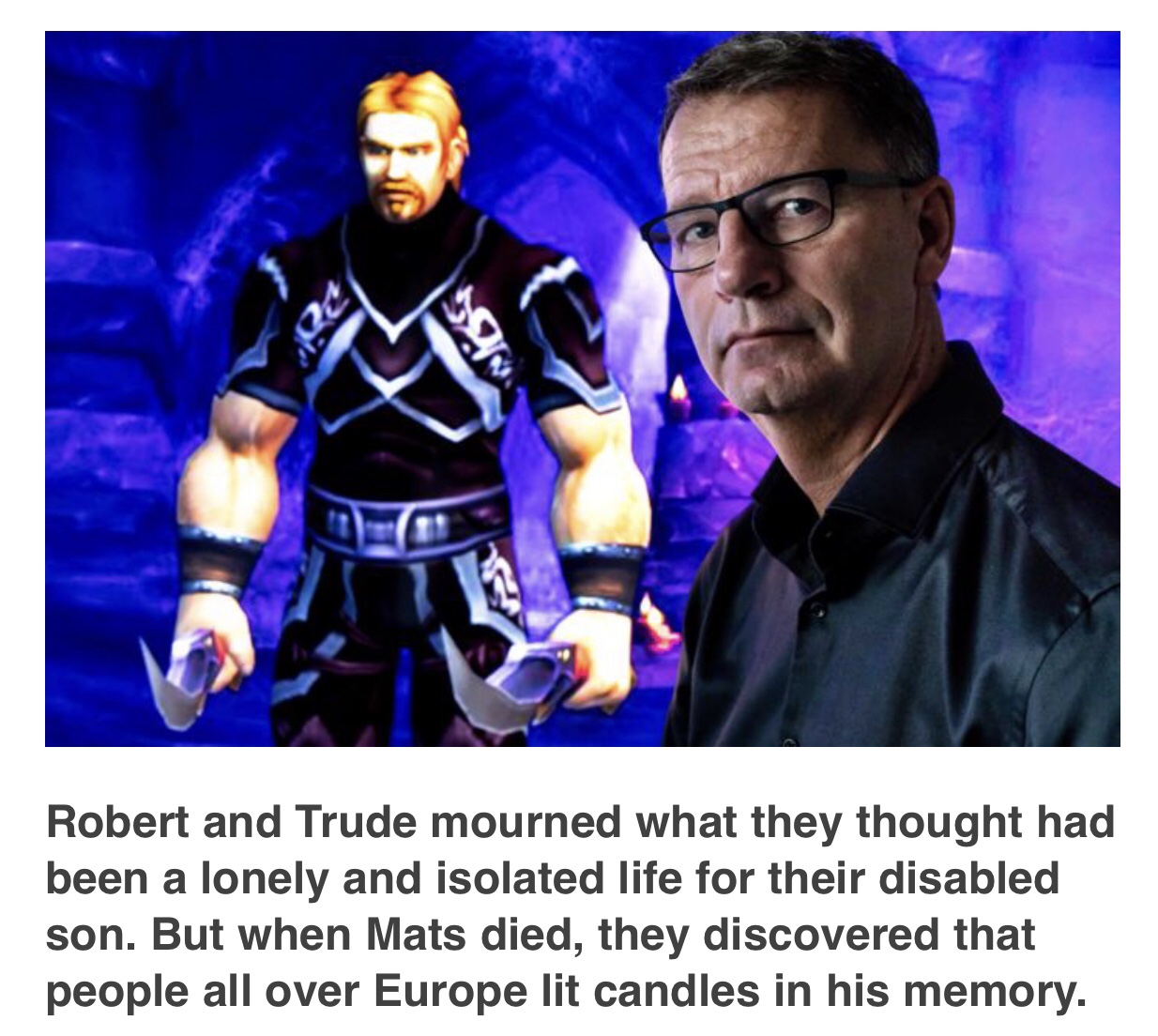
“We were really very traditional. We didn’t want him turning his daily rhythm upside down.”
Sitting in a cafe by his office at Oslo City Hall, Robert Steen describes how he used to worry about his son staying up late into the night.
“In retrospect, I think we should have been more interested in the game world, where he spent so much time,” says 56-year-old Robert. “By not doing so, we robbed ourselves of an opportunity that we didn’t know we had.”
Robert delivered his funeral eulogy for Mats in late 2014, in a chapel at the Norwegian capital’s Western Cemetery.
Among those who sat listening to his words – in-between relatives and a few people from the health service who knew Mats well – was a group of people the family didn’t know.
Only Robert had met them. And only once, the evening before.
Mats had barely left the basement flat underneath his family’s home in the last years of his life, so it was strange that people unknown to the family were present at the funeral.
Even stranger – Mats himself had also never met these people.
Before his death, these grieving visitors would not have thought of Mats as Mats – but instead as Ibelin, a nobleman by birth, a philanderer and a detective. Some of those paying their respects lived close by, but others had come from afar. They wept for their good friend.
Later in the funeral service one of them would speak, and tell the gathering that just now, all across Europe, people were lighting candles for Mats.
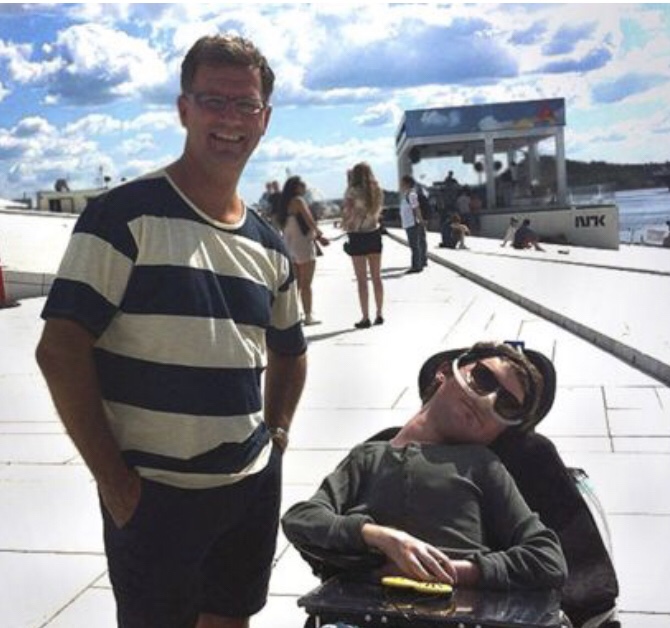
It was written in the stars, it was coded in his DNA.
The Mats that sauntered around with a crown on his head on his fourth birthday in July 1993 would, within a few years, not be able to walk.
Robert and Trude had received the news in May 1993, in a small office in the large brick building that houses Ulleval Hospital.
Mats’s parents learned why their boy kept falling off the swings and hurting himself, why he didn’t climb up the ladder on the slide at the nursery, even though he loved to slide down, why he supported himself on his knees like an old man when he rose from a sitting position and why he didn’t race the other children.
The doctors told Robert and Trude that Mats had Duchenne muscular dystrophy (DMD), a rare disorder that causes muscle degeneration – mostly in boys. Mats’s genes contained a coding error that would prevent his muscles from developing normally. And which would finally destroy them.
“After we put Mats to bed that evening we called the doctor. We had been given permission to do that. We could call any time, if we needed more information,” says Robert.
With Trude sitting by his side, Robert spoke on the phone for more than half-an-hour.
“I said to the doctor: ‘But at least he won’t die from this!’ The doctor on the other end of the line was silent for a moment, ‘no, but our experience is that these patients rarely live to be older than 20’.”
Robert pauses. “He managed to make it to 25.”
At the family home in Ostensjo in south-east Oslo, Robert and Trude tried to take it all in.
Mats would not live what they considered a “normal life”. He would die young and be taken away from them – without having set his mark on the world.
They were so completely mistaken.
If our DNA maps out our lives even before we are born, how can we choose who we want to be? Mats found a way and created himself a new.
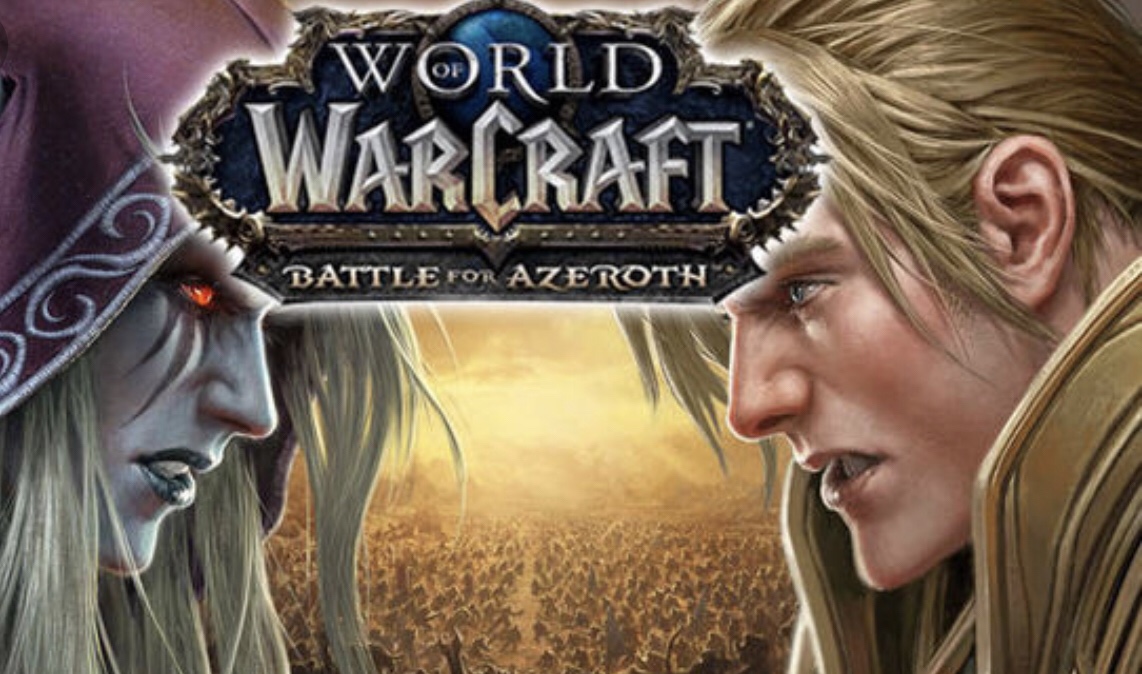
By the turn of the millennium, the Steen family had moved to a wheelchair-adapted home in Langhus, to the south of Oslo.
While Mats was allowed to play his handheld Game Boy during breaks at school, not even Super Mario could chase away the feeling of being different. Mats sat in his wheelchair and an assistant went with him everywhere.
His parents wondered what activity Mats might like to do in his spare time – when his classmates were playing football and running around outside.
Online gaming perhaps? Robert gave him the password to the family PC, and a new world opened up for the 11-year-old.
“In the course of the last 10 years of his life, Mats played between 15,000 and 20,000 hours,” Robert said in his eulogy. “That’s equivalent to more than 10 years’ full-time employment.”
But the gaming also caused family friction.
“When the night nurse arrived at 22:00, Mats had to be in bed,” says Robert. “Their job was to monitor Mats in bed, not to put him to bed. Mats protested but reluctantly agreed.”
Mats had become a gamer. Gamers don’t go to bed early.
So who was Mats during all of those hours he spent playing?
He became Lord Ibelin Redmoore and sometimes Jerome Walker. “Jerome and Ibelin are extensions of myself, they represent different sides of me,” he wrote.
He immersed himself on the planet Azeroth, in the hugely popular game World of Warcraft. Azeroth is a mythical fantasy world. There are continents, seas and forests, cliffs and plains, villages and cities. Mats spent most of his time in a region called the Eastern Kingdoms.
As an online player you get to know this world bit by bit, just as you know your physical world.
There will be places you plan to travel to, and landscapes and cities you will master – some better than others. In some areas you will be on your guard, while in others you will love to hang out. You will find your local inn and meet new, interesting people.
That’s the way the world is. That’s the way Azeroth is.
Mats made the journey and found a wide circle of good friends.
“When I went past Mats’s basement flat during the day and the curtains were closed. That is a sorrow I remember well,” says Robert, who works as Oslo’s vice-mayor of finance.
“‘Oh, no,’ I thought, ‘he hasn’t even started his day yet’. I was sad because his world was so limited.”
But non-gamers don’t see the whole picture. They don’t realise it’s more than just shooting and point-scoring.
“We thought it was all about the game. And just that. We thought it was a competition that you were supposed to win.”
And there was the matter of Mats’s circadian rhythm – his 24-hour daily cycle.
“We didn’t understand why it was important for Mats to be online late in the evening and at night,” says Robert.
“But of course, it isn’t in the morning or in the middle of the day that people are playing. That is when most of them are at school or work.
“We first understood it after he passed away. Until the very end we wanted him to be asleep by 11 at night, like other ‘normal’ people.”
Lisette Roovers, from Breda in the Netherlands, was one of Mats’s close gamer friends. She was also one of those present at the funeral in 2014.
She is in Norway again – visiting friend Kai Simon Fredriksen, who also played online with Mats.
“I knew Mats for many years. It was a shock when he died, and it has shaped me,” says Lisette, sitting on Kai Simon’s sofa in Hoybraten, in north-east Oslo.
Lisette, now 28, was only 15 years old when she met 16-year-old Mats. Or, to be precise, when Lisette’s game character Rumour met Mats’s game character Ibelin. “We met in Goldshire,” says Lisette.
“It’s not a nice place any more, but back then Goldshire was a pleasant little village, where you could meet new, interesting characters. I was looking for someone to role play with, and among others sitting around a campfire was the one I would later learn to know as Ibelin.
“I – or Rumour, rather – acted somewhat impulsively. I jumped out of the bushes and snatched Ibelin’s hat. We stood for a moment, staring back and forth, then I ran away with his hat, with no thought of direction.” She smiles a little.
Mats also wrote about this first meeting with Lisette, in a blog post he called Love.
“In this other world a girl wouldn’t see a wheelchair or anything different. They would get my soul, heart and mind, conveniently placed in a handsome, strong body. Luckily, pretty much every character in this virtual world looks great.”
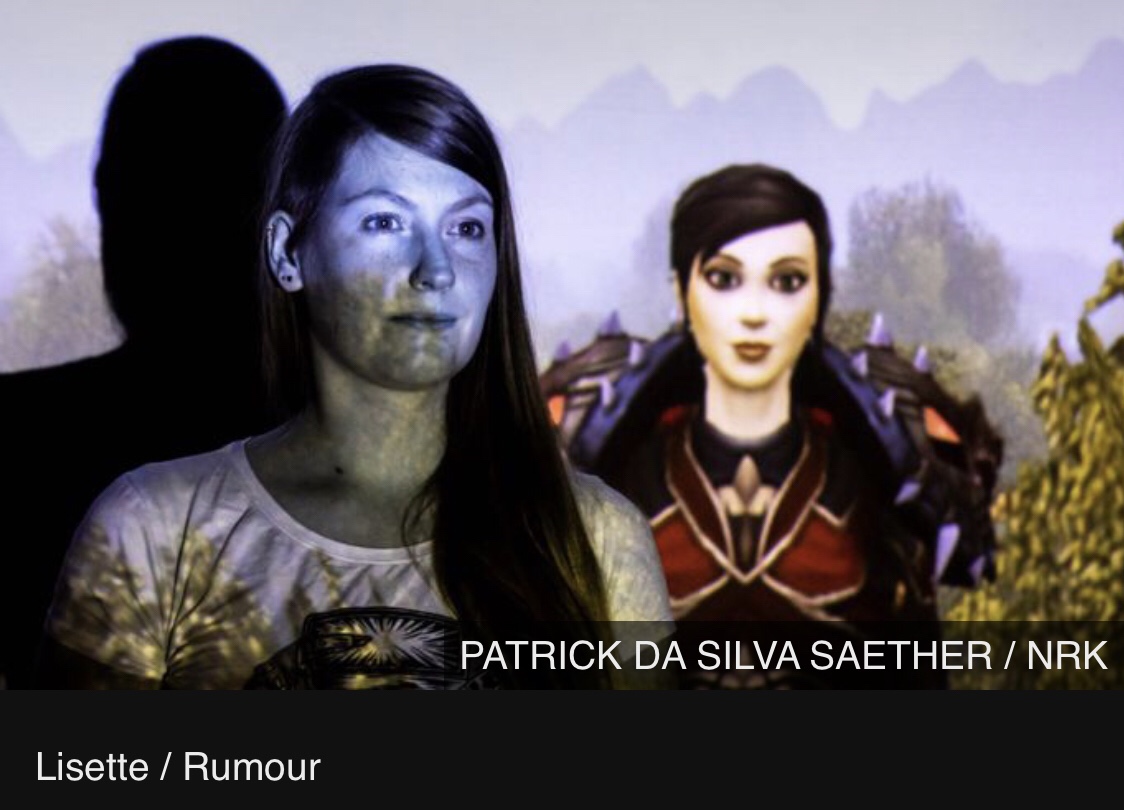
Lisette says: “Mats was a good friend, sometimes a very close friend.
“We wrote [to] each other about everything, but he didn’t write about his condition. I thought his life was like mine. For example, we were both agreed that we hated school.”
But there were things on which they could not agree.
“He wrote that he hated snow. I wrote that I loved it. I didn’t understand then that he hated it because of his wheelchair. I didn’t know about it.”
Teenage Lisette’s love of gaming concerned her parents. They were worried about her school studies and her apparent lack of a social life. Their solution was to restrict her access to online play.
“Being separated from my game friends was hard for me,” Lisette recalls.
But Mats did not fail their friendship. Even if he could not find her in the game, he kept in touch with her through other channels.
“He even wrote a serious letter to my parents, in which he tried to help them understand how important playing was for me,” she says. “I have saved that letter.”
“Mats spoke quite a bit about these game characters – these avatars – but we didn’t think much of it. He told us about Rumour, among others,” says Robert.
“She, or Lisette rather, sent him presents, including on his birthday. We thought that was touching, and we also teased him a bit about it. Then he blushed, really blushed.
“So we thought of Lisette as a friend, because of these presents. They were tangible proof of real friendship, you could say.
“We didn’t call the others he was in touch with, friends. We called them avatars. Our perception of friendship was very traditional.”
In World of Warcraft, you can either play alone or join forces with other players and form a group – or guild. Mats was part of such a group, Starlight, with about 30 members.
“Nobody just becomes a member of Starlight,” says Robert, now educated in the ways of the World of Warcraft. “To become a member you have to be recommended by someone who is already on the inside, then complete a trial period of one to two months.”
Starlight has existed for more than 12 years and is still an active group.
“Starlight is a special group, because it has remained united for so long. That is probably why friendships in Starlight go so deep,” concludes Robert.
Forty-year-old Kai Simon or Nomine, as he is called in the game, is the leader of Starlight.
Every year since Mats’s death in 2014, Starlight has held a memorial to share memories of their comrade.
Last year, Kai Simon told other group members that when remembering Lord Ibelin Redmoore, they should focus on running and swimming.
“Ibelin was a runner,” Kai Simon explains. “It was important for him to be able to run, and it was important for him to be able to share the experience of running with others.”
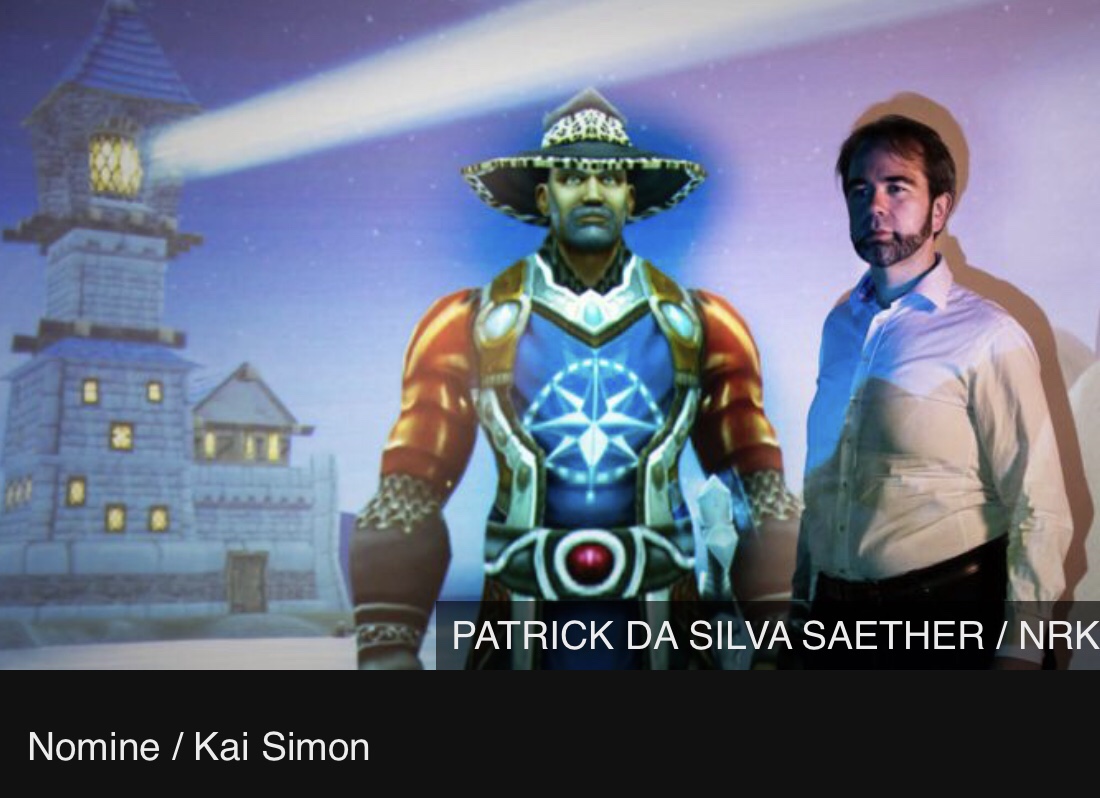
Is Kai Simon now talking about Mats, or about Mats’s game character? Maybe it doesn’t matter. Maybe this is how it was. The person and the character became one.
The youngest person from the gaming world that travelled to Oslo to visit Mats funeral was 14 years old. The oldest was 62. A world without borders, a world without limits, a world beside ours…
Read the full story here (click): A world beside us
You must be logged in to post a comment.